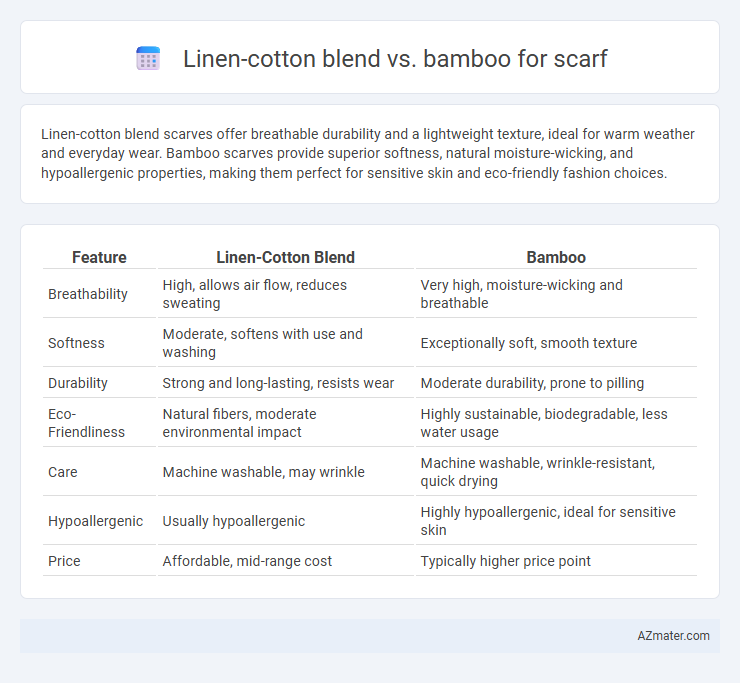Linen-cotton blend scarves offer breathable durability and a lightweight texture, ideal for warm weather and everyday wear. Bamboo scarves provide superior softness, natural moisture-wicking, and hypoallergenic properties, making them perfect for sensitive skin and eco-friendly fashion choices.
Table of Comparison
| Feature | Linen-Cotton Blend | Bamboo |
|---|---|---|
| Breathability | High, allows air flow, reduces sweating | Very high, moisture-wicking and breathable |
| Softness | Moderate, softens with use and washing | Exceptionally soft, smooth texture |
| Durability | Strong and long-lasting, resists wear | Moderate durability, prone to pilling |
| Eco-Friendliness | Natural fibers, moderate environmental impact | Highly sustainable, biodegradable, less water usage |
| Care | Machine washable, may wrinkle | Machine washable, wrinkle-resistant, quick drying |
| Hypoallergenic | Usually hypoallergenic | Highly hypoallergenic, ideal for sensitive skin |
| Price | Affordable, mid-range cost | Typically higher price point |
Overview of Linen-Cotton Blend and Bamboo Fabrics
Linen-cotton blend fabrics combine the breathability and texture of flax fibers with the softness and durability of cotton, making them ideal for lightweight and comfortable scarves. Bamboo fabric is known for its natural moisture-wicking properties, softness, and antibacterial qualities, offering a hypoallergenic and eco-friendly option for scarf wearers. Both materials provide unique benefits in terms of texture, sustainability, and comfort, with linen-cotton blends favoring crispness and bamboo excelling in softness and moisture management.
Breathability and Comfort Comparison
Linen-cotton blend scarves offer exceptional breathability due to the natural fibers' moisture-wicking properties, keeping the skin cool and dry during warm weather. Bamboo scarves excel in softness and hypoallergenic comfort, providing a gentle touch ideal for sensitive skin while maintaining moderate breathability through its natural fibers. Choosing between the two depends on prioritizing crisp, airy ventilation with linen-cotton or silky smooth comfort and antimicrobial benefits offered by bamboo.
Durability and Longevity
Linen-cotton blend scarves offer superior durability due to the strong fibers of flax combined with the softness of cotton, resulting in long-lasting wear resistant to frequent use and washing. Bamboo scarves provide natural antibacterial properties and a silky texture but tend to have a lower abrasion resistance, leading to faster wear over time compared to linen-cotton blends. For longevity in scarves, linen-cotton blends maintain shape and strength better, making them a preferred choice for those seeking extended lifespan in everyday accessories.
Eco-Friendliness and Sustainability
Linen-cotton blend scarves offer eco-friendliness through natural fibers that require less water and pesticides compared to conventional cotton, making them a sustainable choice. Bamboo scarves stand out for their rapid growth and biodegradability, yet concerns about chemical processing during viscose production can impact their environmental footprint. Choosing a scarf crafted from organic linen-cotton or mechanically processed bamboo ensures higher sustainability and reduced ecological impact.
Moisture-Wicking Abilities
Linen-cotton blend scarves are highly effective at moisture-wicking due to the breathable fibers of linen combined with the softness of cotton, making them ideal for keeping skin dry in humid conditions. Bamboo fabric excels in moisture absorption and quick drying, harnessing its natural antibacterial properties to reduce odor and maintain freshness during extended wear. Comparing both, bamboo offers superior moisture management for active use, while linen-cotton provides a balanced combination of durability and breathability for everyday comfort.
Softness and Texture Differences
Linen-cotton blend scarves offer a crisp, slightly coarse texture with moderate softness that improves after washing, providing breathability and durability ideal for warm weather. Bamboo scarves feature a silky, smooth texture with exceptional softness and natural moisture-wicking properties, making them gentle on sensitive skin and suitable for year-round use. The distinct difference lies in linen-cotton's textured, rustic feel versus bamboo's plush, luxurious touch.
Allergy and Skin Sensitivity Concerns
Linen-cotton blend scarves offer breathability and durability, making them suitable for sensitive skin but may cause irritation in individuals with flax or cotton allergies. Bamboo fabric is naturally hypoallergenic, antibacterial, and moisture-wicking, providing excellent comfort for allergy-prone and sensitive skin. Choosing bamboo scarves reduces the risk of skin irritation and is ideal for those seeking gentle, breathable material against the skin.
Style Versatility and Appearance
Linen-cotton blend scarves offer a crisp, textured appearance that enhances both casual and formal outfits with a natural, breathable fabric ideal for spring and summer wear. Bamboo scarves present a smooth, silky finish with a subtle sheen, providing a luxurious look that pairs well with elegant and contemporary styles while maintaining eco-friendly appeal. Both materials deliver excellent drape and color retention, but linen-cotton blends excel in adding structured dimension, whereas bamboo emphasizes softness and fluidity.
Care and Maintenance Requirements
Linen-cotton blend scarves require gentle hand washing or machine washing on a delicate cycle with cold water to prevent shrinking and preserve fabric integrity, coupled with air drying or low-heat ironing to maintain softness. Bamboo scarves benefit from similar gentle washing but have the added advantage of natural antibacterial properties that reduce odor build-up, allowing less frequent cleaning. Both fabrics need avoidance of bleach and harsh detergents to prolong scarf lifespan while preserving fiber strength and color vibrancy.
Price and Value for Money
Linen-cotton blend scarves typically offer a balanced price point with durable fabric that combines breathability and softness, making them a cost-effective choice for daily wear. Bamboo scarves, while often pricier due to their eco-friendly production and natural antibacterial properties, provide superior softness and moisture-wicking benefits that justify the investment for those seeking sustainable luxury. Evaluating price against longevity and comfort, linen-cotton blends deliver robust value for money, whereas bamboo excels in premium appeal and enhanced functional benefits.

Infographic: Linen-cotton blend vs Bamboo for Scarf
 azmater.com
azmater.com